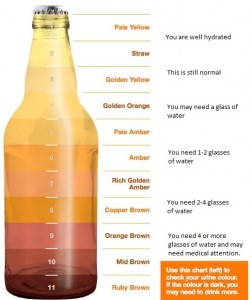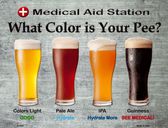There are many symptoms to dehydration that I listed in a previous post. When not exercising, this is a good time to take the urine color test for hydration – the darker the color, the more water you need (and maybe electrolytes, too!). When exercising, this is probably not that great of an indicator as most of us will have a darker urine color after we exercise, even if are hydrating. The key is to keep an eye on it before and after to get a better picture of your hydration levels.
The kidneys will concentrate the urine in an effort to conserve water. Sometimes it empties the bladder to help concentrate electrolytes in the body in an effort to slow the rate of dehydration. (hence ‘going to pee’ frequently while exercising can actually mean you are dehydrating and need more electrolytes to keep the water inside the cells as needed vs. you are actually hydrating well).
Theoretically, based on ACSM (American College of Sports Medicine) guidelines, the recommendation is to consume 14-32 ounces of water per hour. 1 L is the maximum which is about 34 ounces – the body just cannot process that! When exercising, especially running, there is no way to consume 34 oz of liquid in an hour.
A good way to check your hydration levels can be using a urine color test – a chart. The less color, the more hydrated you are. The darker the color, the more dehydrated you are. Although totally clear and no color may mean you are over-hydrated. Not very complicated!
For athletes, if you finish your session of exercise and your urine is really dark, you need to get more water into you. Keep drinking your water and checking every hour to see if the color has improved. If in a few hours of going to pee, if it does not improve, a trip to the doctor is probably in order or maybe the ER. It can take several days to weeks to recover from dehydration fully. Checking the urine color may be a good indicator as to how good of a job with hydration you are doing during the day or whether you have recovered and your symptoms of dehydration have also subsided.
NOTE: It is OK and normal to have yellow urine if you are taking a multi or B-complex vitamin. Then your urine would be a glowing yellow.
NOTE: The only time it is acceptable that your urine is reddish in color is if you have eaten beets or drank beet juice – you will think you are internally bleeding (which is a problem requiring medical attention!!) but it is just the red from the beets you ate. Scares me every time!
As you can see from the graphic on the side, the levels of color change are pretty obvious. You may also notice, that when you are dehydrated and needing more water, the amount of urine output is half of what it should be or less than that! This is a sign you will need to continue drinking 8 ounces of water per hour until the color level returns closer to a normal level.
NOTE: When you wake up in the morning after 8 hours of sleep, you are dehydrated to a degree. The color of that pee is highly concentrated at that time of morning. It is the rest of the day you want to make sure it becomes clearer.
If it is clear and you still have issues with dehydration symptoms, then you need to add electrolytes and add them quickly as your body is not utilizing the water and the water is not being absorbed. Rather it is just going right thru you and not into the cells where you want it. I can help you sort thru which supplements to use for this and which foods can help with electrolytes based on the symptoms. (certain symptoms correlate with specific electrolytes)
For those who drink beer regularly, which many athletes do after events, beer doesn’t help with hydration if you have more than one… but it totally does hit the spot after a race or longer 2-4 hour ride!
Alcohol can lead to dehydration, so be careful how much you consume the evening before and that same day after an event’s celebratory beer has been consumed. 1 drink is enough to calm the nerves, but 2 may lead to dehydration.
If your urine looks like a IPA or Pale Ale, drink more water instead of beer. If it looks like a Guinness or stout, you don’t need to drink more water…you need to seek medical attention immediately!
A general rule of thumb in terms of how much water to take in per day is by taking your weight and dividing it by 2. This will provide you with the number of ounces of water you should be taking in per day. If you can check your urine color, you can determine if you are getting close to that optimal level or not.
References: https://phc.amedd.army.mil/